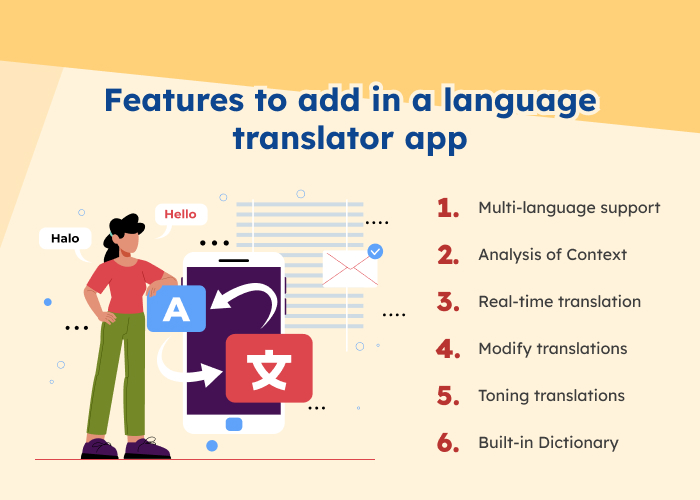Cost factors of a language translator app
An app like Papago, Google Translation, etc, which is well-known for its sophisticated features and precise translations, takes a long time to develop and requires careful consideration of many variables that affect the ultimate cost. Here are some important things to think about:
- Complexity: The whole cost of producing a translation app is heavily influenced by its technological sophistication. Because each language must be trained and integrated separately, multilingual assistance increases development time and complexity. Furthermore, the project’s overall costs will also be impacted by the need for code optimization and the construction of server infrastructure in order to achieve real-time translation speeds.
- UI/UX Design: Creating a user experience that is both aesthetically pleasing and intuitive is crucial. This calls for talented designers with the ability to make user-centered designs. Moreover, usability testing is required to guarantee a flawless user experience. Thus, the ultimate cost of developing a translation app is influenced by all of these procedures.
- App Platform: Developing for several platforms—web, mobile, and desktop—increases the complexity of the work. Making sure the software runs smoothly on other operating systems, such as iOS and Android, might add a substantial amount to the total cost.
- Location of Development Team: The app development cost is also influenced by the location of the employed app development business. For example, depending on the location, hourly costs for app development services differ considerably. You can expect cost-effective development of a language translator app by an app development company based in India compared to the USA.
- Post-Deployment: Updating, maintaining, and providing support must be done consistently to keep an app relevant. Together, these efforts will raise the price of developing translation apps overall.
Features to add in a language translator app

Now let’s examine the many factors that can go into making a strong translation app like Papago, google, and more. It is critical to realize that each of these app features plays a part in the overall efficacy and user happiness.
Multi-language support
A language translator app should have strong multilingual support in order to handle the heterogeneous language environment. This implies that users ought to have no trouble translating text between different languages. In order to provide the best possible user experience, each language should undergo customized training and integration during the development phase.
Analysis of Context
The translation app should analyze the context of the words and translate the language easily. To help the app comprehend and replicate context, more complex algorithms and substantial data training are needed, which will create translations that are more accurate.
Real-time translation
Among the notable features that may be included to make an app similar to popular translator apps is real-time translation. Optimized code and a good server are needed. This leads to incredibly quick translation times.
Modify translations
Users should be able to easily customize translations to fit their context with the app. With only a click, they may select other words or phrases, which ensures accuracy and saves time.
Toning translations
The language translator app should allow modification of tones in the translation. For example, a simple tone can be modified to formal or can be expanded. This way, the translations can be more accurate and allow room for more personalization.
Built-in Dictionary
The app should allow users to add their own words to the dictionary and also have an in-built dictionary. This way, the users can find the meaning of the words used in the sentence and can customize them based on their preferences.
Conclusion
A language translation app’s total cost is determined by a number of aspects that are involved in its development. These elements include business, design, and technological aspects. The amount spent on development is mostly determined by the intricacy of the application, the number of languages it supports, the caliber of the translations, and the features it integrates.
The budget may also be impacted by other elements such as the platform of choice (iOS, Android, or cross-platform), the use of machine learning models for translation, and the requirement for extra features like voice recognition or offline mode. In conclusion, meticulous planning, user experience in mind, strong technical integration, and continuous support for updates and enhancements are necessary for a language translation app to be successful.
FAQs
What is the best app to translate any language?
Papago is the best app to translate any language.
Is the language translator app free?
Yes, many language translation apps are available for free.
What factors influence the cost of developing a language translator app?
Several factors impact the cost, including the complexity of the app, the number of supported languages, translation quality, additional features, development platform, and ongoing maintenance.
How can I reduce the cost of developing a language translator app?
To reduce costs, consider limiting the number of supported languages initially, focusing on essential features, and choosing a single development platform. Additionally, working with experienced developers from India and having a well-defined project scope can help control expenses.
Is ongoing maintenance included in the development cost?
Ongoing maintenance is typically a separate cost from the initial development. It includes updates, bug fixes, and support services after the app is launched. It’s crucial to budget for maintenance to ensure the app’s long-term functionality.
Ravi Bhojani is the Chief Marketing Officer (CMO) at Alian Software, where he spearheads the company’s marketing strategies and drives its brand presence in the competitive IT services landscape. With over a decade of experience in the technology and marketing sectors, Ravi has consistently demonstrated his ability to blend innovative marketing techniques with deep industry knowledge to deliver outstanding results.